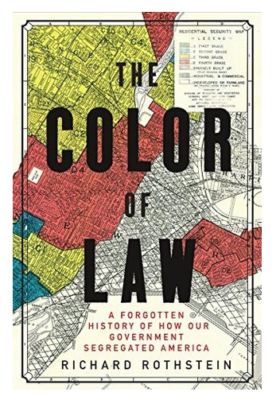The Color of Law – Richard Rothstein
(April 2018) On Wednesday, April 11, 2018, 90-year-old Walter F. Mondale wrote an op-ed about the 50th anniversary of the Fair Housing Act, which he co-authored as a U.S. Senator. The next day, a 14-year-old black student in Detroit was shot at by a homeowner when he rang their doorbell asking for directions to his high school. The Color of Law explains why a hundred years of public policy designed to segregate neighborhoods and communities made that moment inevitable, despite the 1968 Fair Housing Act.
Author Richard Rothstein sets out to show how unconstitutional laws and unconstitutional public policies set up a system of de jure racial segregation in housing. Where once there was integrated housing and neighborhoods a century ago, a system of establishing “whites only” and “blacks only” housing and neighborhoods was engineered and promoted from the Oval Office and the Supreme Court to State Legislatures and City Planning Commissions, passing through court rooms that refused to uphold the tenants of our U.S. Constitution’s 5th and 14th Amendments.
In the Jim Crow era following reconstruction, there was collusion at every level to deny African Americans the right to buy housing any place where they could afford it. Integrated neighborhoods were systematically dismantled and policies put into place that would create separate and unequal housing for black Americans.
In 1926, the same year that the U.S. Supreme Court upheld exclusionary zoning, it also upheld restrictive covenants, finding that they were voluntary private contracts, not state action. With this decision to rely upon, successive presidential administrations embraced covenants as a mean of segregating the nation.
This march toward segregation in housing was exacerbated by the acceleration of home construction during World War II to support war workers around the country. The migration of black workers to industrial centers following war jobs, created a sudden influx of African Americans needing housing where there was none. The hasty construction of war housing created separate and very unequal communities, setting a pattern that would continue for decades afterward.
The post war housing boom in the 40’s and 50’s was fueled by GI bills and VA loans that made it possible for WHITE war veterans to afford to own their own homes in suburban neighborhoods that were “whites only.” Black war veterans were not able to use the benefits GI bills provided for housing and higher education. Very few higher educational institutions would even accept black students. And there were few homes for African Americans to buy and the housing finance industry would not approve mortgages for homes in “red lined zones.” The history of the Fair Housing Authority (FHA) is a dark one.
Rothstein does an outstanding job in presenting thorough and credible research about how segregated neighborhoods were a result of unconstitutional de jure policies rather than any de facto settlement patterns. He explores how discrimination in educational opportunities, within the federal civil service and the military, and even within labor unions systematically disadvantaged African Americans and depressed their earning potential. That disadvantage persists from one generation to the next. The heritable wealth that white Americans have passed down from one generation to the next has created a wealth gap in this country that will not be easily reversed by any policies created moving forward.
The neighborhoods created for “blacks only” were often on the edge of industrial and commercial zones used as buffers between white suburban neighborhoods and black communities. The proximity of that housing to industrial toxins and pollution are factors that have impacted the health of African Americans living in those communities. When we speak of “social determinants of health” things like the location of housing, overcrowding, the lack of job opportunities, food deserts and the lack of adequate public transportation all lead to poor health outcomes in predominantly black neighborhoods.
The role that the mortgage and real estate industries played in segregating the country is appalling. The “block busting” that preyed upon white homeowners and black homebuyers alike by real estate agents is unconscionable and for far too many years it went on unabated. The sub prime mortgage debacle a mere decade ago greatly disadvantaged minority homebuyers and homeowners and resulted in many losing their homes.
Upholding the validity of housing covenants right through the 1960s has left us with deeply segregated neighborhoods that have subsequently led to very segregated public schools. To this day, the zoning policies of towns, cities and counties across the country determine what types of housing are built, who can afford to live there, and how that housing stock impacts the make up of public school classrooms. The phrase “residential character of our neighborhoods” takes on a whole new meaning after reading this book.
I finished this book asking myself – again – why we do not teach public school students about the economic history of this country. The national mythology that passes itself off as history in our textbooks and school curriculums does not provide a foundation for young people to make better decisions as adults than their own parents did. We are truly ignorant of our own history and I see no movement to correct that.
The Color of Law would make an excellent AP History textbook. Our history does not dictate our future – unless we don’t know that history – in which case it’s very likely we will continue to make the same mistakes over and over again. I highly recommend this book to everyone.
